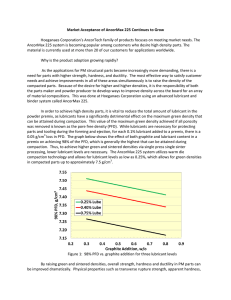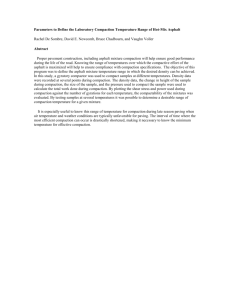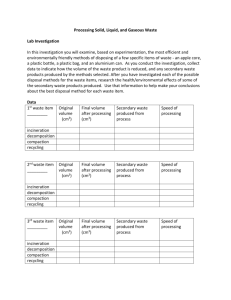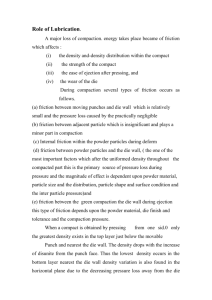Warm Compaction and Warm-Die Compaction of Ferrous PM Materials
advertisement
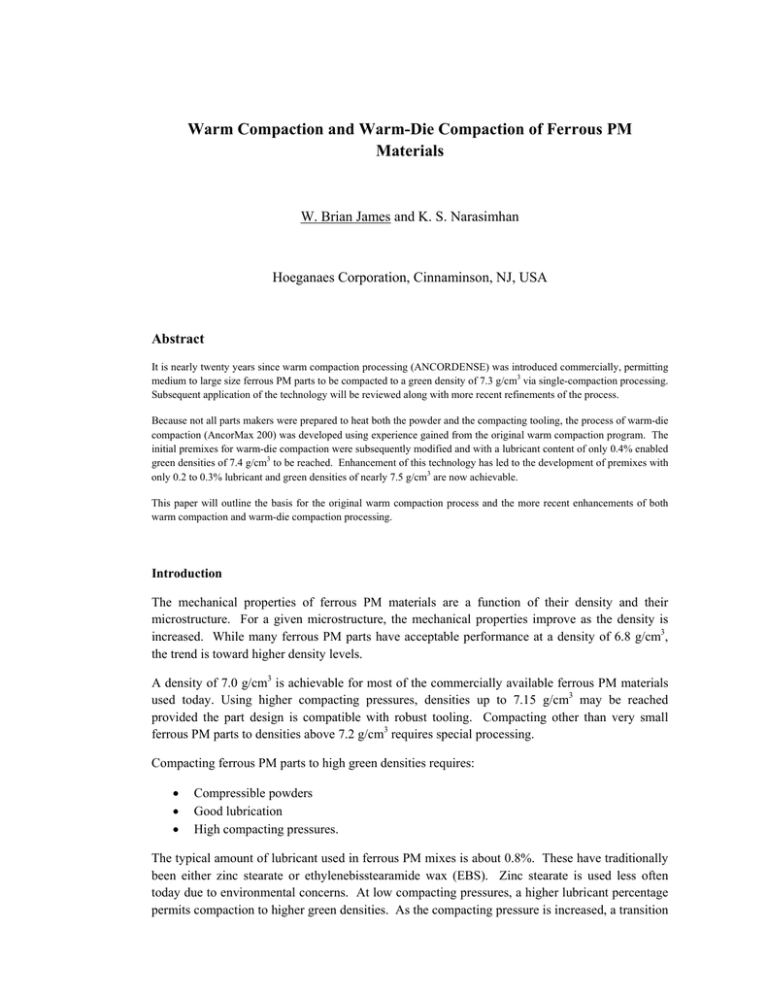
Warm Compaction and Warm-Die Compaction of Ferrous PM Materials W. Brian James and K. S. Narasimhan Hoeganaes Corporation, Cinnaminson, NJ, USA Abstract It is nearly twenty years since warm compaction processing (ANCORDENSE) was introduced commercially, permitting medium to large size ferrous PM parts to be compacted to a green density of 7.3 g/cm3 via single-compaction processing. Subsequent application of the technology will be reviewed along with more recent refinements of the process. Because not all parts makers were prepared to heat both the powder and the compacting tooling, the process of warm-die compaction (AncorMax 200) was developed using experience gained from the original warm compaction program. The initial premixes for warm-die compaction were subsequently modified and with a lubricant content of only 0.4% enabled green densities of 7.4 g/cm3 to be reached. Enhancement of this technology has led to the development of premixes with only 0.2 to 0.3% lubricant and green densities of nearly 7.5 g/cm3 are now achievable. This paper will outline the basis for the original warm compaction process and the more recent enhancements of both warm compaction and warm-die compaction processing. Introduction The mechanical properties of ferrous PM materials are a function of their density and their microstructure. For a given microstructure, the mechanical properties improve as the density is increased. While many ferrous PM parts have acceptable performance at a density of 6.8 g/cm3, the trend is toward higher density levels. A density of 7.0 g/cm3 is achievable for most of the commercially available ferrous PM materials used today. Using higher compacting pressures, densities up to 7.15 g/cm3 may be reached provided the part design is compatible with robust tooling. Compacting other than very small ferrous PM parts to densities above 7.2 g/cm3 requires special processing. Compacting ferrous PM parts to high green densities requires: Compressible powders Good lubrication High compacting pressures. The typical amount of lubricant used in ferrous PM mixes is about 0.8%. These have traditionally been either zinc stearate or ethylenebisstearamide wax (EBS). Zinc stearate is used less often today due to environmental concerns. At low compacting pressures, a higher lubricant percentage permits compaction to higher green densities. As the compacting pressure is increased, a transition pressure is reached where the added lubricant impedes the compaction process and prevents higher green densities being reached – Figure 1. The effect was highlighted by Yarnton and Davies [1]. Die-wall lubrication permits higher green densities to be reached than are possible when mixes contain admixed lubricant. Unfortunately, commercial application of die-wall lubrication technology is limited to relatively thin parts with fairly simple shapes. Fig 1: Effect of lubricant content on compressibility Warm Compaction During compaction, frictional heat leads to an increase in the temperature of the compacting punches, core rods (if present), and the die. Research was conducted to see whether even higher temperatures than those encountered in conventional compaction resulted in an increase in the density of green compacts. These higher temperatures for compaction required the use of different lubricants that would maintain their lubricity at the higher temperatures. The research led to the development of binder-treated premixes for what we now call warm compaction [2-4]. In warm compaction processing, both the powder and the compacting tooling (upper punch and die) are heated (120 °C to 145 °C) and with 0.6% lubricant a green density of 7.3 g/cm3 is possible. With the special binder-lubricant system developed for warm compaction processing it is possible to reduce the lubricant addition to 0.6%. This we now know is essential to the ability to reach a green density of 7.3 g/cm3. In order to understand the reason for this we need to go back to the concept of the “transition” pressure introduced by Yarnton and Davies and to introduce the concept of pore-free density. The pore-free density of a powder mix is the density of the compacted mix if all of the porosity could be removed. This is a conceptual rather than a practical objective. While we may be able to compact a powder mix to a point where all of the porosity is eliminated, the green compact expands on ejection from the die cavity thereby increasing volume without gaining mass – effectively reducing the green density. The densities of mix additives such as the lubricant and the admixed graphite are considerably different from the density of the iron powder or the prealloyed low-alloy base powder being compacted. Lubricants have a density of about 1 g/cm3, graphite 2.3 g/cm3, while iron and the prealloyed base powders have a density of about 7.84 g/cm3 (this is lower than the theoretical density of iron due to the presence of nonmetallic inclusions in the iron and low-alloy material). As lubricants have such a low density, they occupy a relatively high volume in the powder compact. While the admixed mass percent of a lubricant might be 0.8% it represents over 7% by volume. When we compact the powder mix at higher pressures the lubricant, rather than helping to reduce frictional forces, starts to impede further densification as there are no more pore spaces or powder surfaces to which the lubricant can move. The pore-free density of a powder mix may be calculated based on the mass percent of the various constituents of the mix and their respective densities. Dividing the mass percent of the ingredient by its density leads to the volume occupied by the ingredient in a pore-free material. Summing the individual volumes and dividing the mass of the compact by this volume leads to the pore-free density of the material. In practice it has been found that green densities that are 98% of the pore-free density may be achieved for simple shapes compacted under laboratory conditions. This has been demonstrated for hundreds of mix compositions. For example, take a mix of the following composition (mass %): Iron (96.6%) + 2% nickel + 0.6% graphite + 0.8% lubricant Pore-free volume = (96.6/7.84 + 2/8.85 + 0.6/2.3 + 0.8/1.0) = 13.61 cm3 Pore-free density = 100/13.61 = 7.35 g/cm3 and 98% of 7.35 g/cm3 = 7.20 g/cm3. A similar calculation for the above mix but with a lubricant content of 0.6% leads to a pore-free density of 7.45 g/cm3 and a 98% value of 7.30 g/cm3. The effect of various amounts of lubricant on the above mix composition may be seen in Figure 2. Fig 2: The effect of lubricant content on the pore-free density of the mix - iron + 2% nickel + 0.6% graphite + lubricant The relative effect of lubricant and graphite on the pore-free density is summarized in Figure 3. Decreasing the lubricant content by 0.2% increases the pore-free density by 0.1 g/cm3. Compressibility curves for the compaction of FLN2-4405 (Ancorsteel® 85 HP + 2% Ni + 0.4% graphite + 0.6% lubricant) via conventional compaction and via warm compaction (ANCORDENSE®) processing are presented in Figure 4 [4]. Heating of the compacting tooling may be accomplished via cartridge heaters inserted in the die body and a band heater around the upper punch. It is not easy to heat powder uniformly and effectively. Commercial powder heating systems have been developed. One utilizes a heated screw conveyor (Figure 5a) while another employs the transfer of heat via oil heated panels (Figure 5b). Warm-Die Compaction Some parts makers embraced the warm compaction technology with open arms and made parts ranging from small to medium size gears for power tools to torque converter hubs for automotive automatic transmissions. Others were not comfortable with heating both the powder and the compacting tools and wanted a process where the powder did not need to be heated. Further research led to the development of what we now call warm-die compaction [5,6]. The benchmark Fig 3: The relative effect of lubricant and graphite on pore-free density Fig 4: Compressibility curves for FLN2-4405 Fig 5a: EL-TEMP heated screw system from Cincinnati Inc. Fig 5b: TPP 300 Thermal Powder Processor from Abbott Furnace Co. for the development of the warm-die compaction process was a mix with 0.75% Acrawax C (EBS) lubricant. This represents a lubricant type and amount that is commonly used in commercial practice. The objective was to develop the ability to achieve high green densities while maintaining the surface finish of the green compacts at the same level as that obtained when using the 0.75% EBS lubricant. Compressibility curves for an FLN2-4405 material compacted via both warm-die compaction and conventional processing are presented in Figure 6a [5]. The green expansion relative to green density is summarized in Figure 6b [5]. Fig 6a: Compressibility curves for FLN2-4405. Part temperature on ejection 93 °C Fig 6b: Green expansion vs. green density for FLN2-4405. Part temperature on ejection 93 °C The green expansion for the warm-die compacted material is less than that of the material with 0.75% EBS lubricant, particularly as the green density is increased. The green strength of the warm-die compacted material is significantly higher than that of the conventionally processed material – Figure 7 [5]. Fig 7: Green strength of FLN2-4405 as a function of green density. Part temperature on ejection 93 °C The ejection stress (strip and slide) was significantly reduced for the warm-die compacted material compared with the mix that contained 0.75% EBS lubricant – Figure 8a and 8b [5] and the surface finish was as good or better – Figure 9a and 9b. In addition to simple geometric shapes, the warmdie compaction process has been used to compact structural parts such as the gear shown in Figure 10. This 32 mm tall part was compacted on a Dorst 140 t mechanical press at a stroke rate of 10 parts per minute. Fig 8a: Ejection curves for FLN2-4405 compacted at 550 MPa. Part temperature on ejection 93 °C Fig 8b: Ejection curves for FLN2-4405 compacted at 830 MPa. Part temperature on ejection 93 °C Fig 9a: Surface finish of the cylinders compacted at 550 MPa. Part temperature on ejection 93 °C Fig 9b: Surface finish of the cylinders compacted at 830 MPa. Part temperature on ejection 93 °C Fig 10: 32 mm tall PM gear compacted on a 140 t mechanical press at a stroke rate of 10 parts per minute The warm-die compaction process is ideal for small to medium size parts that can be compacted at high pressures. If parts have a wall thickness of about 19 mm or greater or they have a mass of greater than 700 g then warm compaction (ANCORDENSE) processing is recommended as the short contact time with the die and inefficient thermal transfer makes warm-die compaction of such parts difficult. The optimum temperature for the surface of the green parts on compaction is 93 °C but temperatures of from 80 °C to 105 °C are acceptable depending on whether maximum green density is the objective. A significant benefit of the AncorMax 200 warm-die compaction system is that the surface of the compacted green part is not sticky. This is not the case for some alternative warm-die compaction systems and this can lead to a problem when die table powder sticks to the surface of the green compact. Parts greater than 35 mm thick may not be practical for the warm-die compaction process unless slightly more lubricant is added. The additional lubricant will limit the green density that can be achieved because it reduces the pore-free density of the material. Some parts makers have converted warm compacted parts to warm-die compaction processing. Others, who did not use warm compaction, have started to use warm-die compaction processing. The higher green density achievable through warm-die compaction is illustrated in Figure 11 [7]. Fig 11: Compressibility curves for FLN2-4400 (0.35% graphite) A practical consideration when processing parts to such high green densities is the need to permit the air in the powder mass time to escape. A 200 g part compacted to a 7.3 g/cm3 green density from a mix with an apparent density of 3.10 g/cm3 has a compression ratio of 2.35 and there will be about 90 cm3 of air that needs to be released during compaction. A short dwell time when using an hydraulic press will permit the air to escape. Programing a short dwell at a crank angle of 160° will do the same when using a mechanical compacting press. If the air is not permitted to escape there is a danger of over pressing and the green part may have lamination cracks. Rather than use the warm-die compaction process to maximize the green density (about 7.4 g/cm3 at a 0.4% lubricant level) some parts makers have applied the technology to compact parts to densities between 7.2 to 7.3 g/cm3. This permits the use of slightly lower compacting pressures (600 to 700 MPa) compared with the pressure needed to achieve the higher green density (830 MPa plus). Enhanced Warm Compaction and Warm-Die Compaction Ongoing research has led to the development of enhanced versions of the original warm compaction and warm-die compaction processes. A warm compaction process that uses a different lubricant has been developed. In the new process the powder and tools are heated to 135 °C to 160 °C (compared with 120 °C to 145 °C for the original ANCORDENSE process). The new lubricant system is very efficient and the lubricant addition may be reduced to 0.3% . This enables green densities of over 7.4 g/cm3 to be achieved. – Figure 12 [7]. The new warm compaction process is called ANCORDENSE 450. Fig 12: Influence of processing parameters on the compressibility of FLN2-4400 (0.35% graphite) Further refinement of the original warm-die compaction process (AncorMax 200) has led to the development of AncorMax 225. This new warm-die compaction process operates best when the temperature of the ejected green compact is 107 °C. The special lubricant system is particularly effective and the lubricant content of AncorMax 225 premixes can be as low as 0.2%-0.3%. The compressibility of an FN-0205 premix made with AncorMax 225 processing is shown in Figure 13a and the green strength of the material in Figure 13b [8]. Extremely high green strengths are possible when using this process. A comparison of the ejection characteristics of an FN-0205 material warm-die compacted at different temperatures and with different amounts and types of lubricant is presented in Figure 14 [8]. Fig 13a: Compressibility of AncorMax 225 compacted FN-0205 Fig 13b: Green strength of AncorMax 225 compacted FN-0205 Fig 14: A comparison of the ejection characteristics of an FN-0205 material warm-die compacted at different temperatures and with different amounts and types of lubricant RT = room temperature Summary A comparison between the various warm compaction and warm-die compaction processes is presented in Table 1. TABLE 1: Comparison between various warm compaction and warm-die compaction processes References 1. D. Yarnton and T.J. Davies., “The Effect of Lubrication on the Compaction and Sintering of Iron Powder Compacts”, International Journal of Powder Metallurgy 8 (2), 1972, p. 51. 2. U.S. Patent 5154881, H.G. Rutz and S.H. Luk, “Method of Making a Sintered Metal Component”. 3. H.G. Rutz and F.G. Hanejko, “High Density Processing of High Performance Ferrous Materials”, Advances in Powder Metallurgy & Particulate Materials – 1994, Volume 5, p. 117, compiled by Chaman Lall and Albert Neupaver, published by Metal Powder Industries Federation, Princeton, NJ. 4. S.H. Luk, H.G. Rutz, and M.A. Lutz, “Properties of High Density Ferrous P/M Materials – A study of Various Processes”, Advances in Powder Metallurgy & Particulate Materials – 1994, Volume 5, p. 135, compiled by Chaman Lall and Albert Neupaver, published by Metal Powder Industries Federation, Princeton, NJ. 5. F.G. Hanejko, G. Poszmik, P. King, and A.J. Rawlings, “Processing of PM Materials to a Density of 7.5 g/cm3 by Conventional pressing and Sintering, presented at Special Interest Program at PowderMet2006 in San Diego, CA. 6. F.G. Hanejko, “High Density via Single Pressing/Single Sintering, Euro PM2007, Toulouse, France, Vol. 3, p.15, published by European Powder Metallurgy Association. 7. F.G. Hanejko and S. Clisby, “A New Premixing and Compaction System to Achieve Green densities >7.4 g/cm3, presented at Special Interest Program at PowderMet2008 in Washington, DC. 8. F.G. Hanejko, W. Tambussi, and Jeanne Hooker, “Advances in Lubrication Technology in PM to Promote Higher Sintered Densities, presented at Special Interest Program at PowderMet2012 in Nashville, TN.

